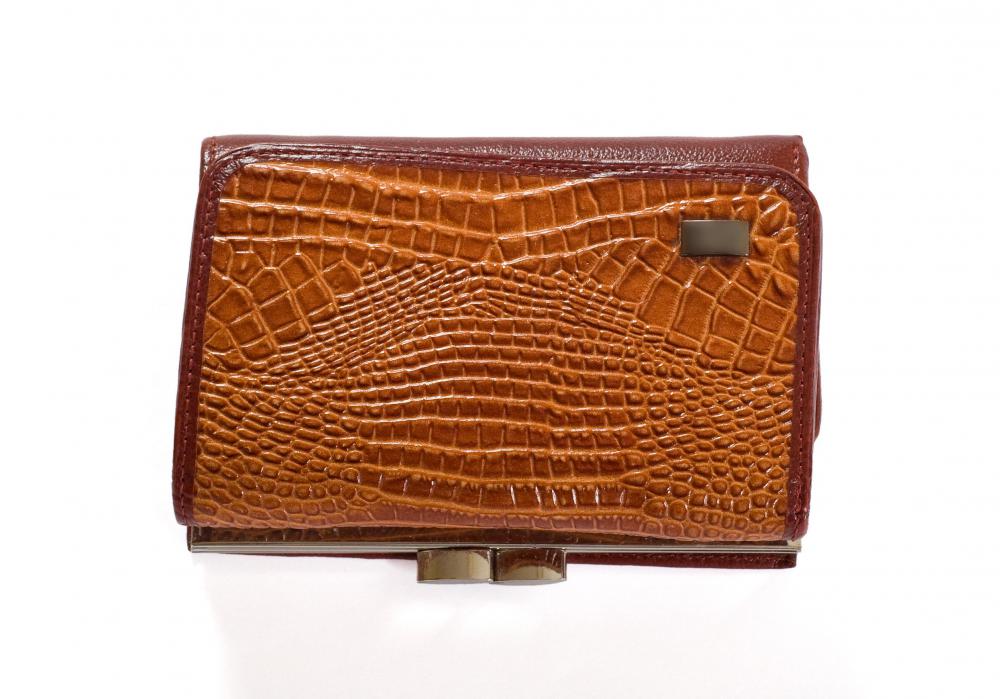At AllThingsNature, we're committed to delivering accurate, trustworthy information. Our expert-authored content is rigorously fact-checked and sourced from credible authorities. Discover how we uphold the highest standards in providing you with reliable knowledge.
What are Dermal Pressure Receptors?
Dermal pressure receptors (DPRs) are dotted sensory pits found on the scales of animals in the Crocodilia order, which includes alligators, caimans, and crocodiles. Animals in the Alligatorinae family of this order only have the pits in the head area, mainly along the jawline, eyes, nose and upper palate. Animals in the Crocodylidae and Gavialinae families have them distributed over their entire bodies.
Before being given their current name, these sensory receptors were called integumentary sense organs (ISOs) because of their location in the integumentary or outer layer of the skin. Along the jaw line, they resemble black beard stubble and there may be as many as three or four receptors at the outer edges of a single scale. On other areas of the body, such as the belly of a crocodile, DPRs are often white, and there may only be one per scale.

Dermal pressure receptors are not well understood, but it is assumed that their function differs depending on where they are located on the animal's body. Those on the head are very sensitive to the slightest changes in pressure from surrounding water. When a fish swims within close proximity, for example, the disturbance creates tiny waves that impinge on the receptors. The sensation alerts the crocodile or alligator of not only the presence but the precise location of prey, even in murky water where vision is poor. At the surface when languidly resting with eyes and nostrils exposed, an animal might instantly thrash out and catch underwater prey that was otherwise entirely undetectable.

Alligators are mainly found in fresh water while crocodiles live in brackish or salt water, leading some researchers to theorize that the dermal pressure receptors covering the crocodile's body might be involved in chemical reception or salinity detection, but there is no conclusive evidence.
After surviving nearly 200 million years virtually unchanged, crocodile and alligator skin became popular in the 1900s, which led to hunting the animals nearly to extinction. Due to conservationists efforts, alligators have recovered and regulated trade of skins is legal once again. Crocodiles remain on the endangered species list, however. If buying boots, belts or other items advertised as alligator skin, there should be no sign of these receptors, as the skin comes from the belly where they are not found on this animal. If they are present on some or all of the scales, the item is not made from alligator skin.

Dermal pressure receptors (DPRs) are dotted sensory pits found on the scales of animals in the Crocodilia order, which includes alligators, caimans, and crocodiles. Animals in the Alligatorinae family of this order only have the pits in the head area, mainly along the jawline, eyes, nose and upper palate. Animals in the Crocodylidae and Gavialinae families have them distributed over their entire bodies.
Before being given their current name, these sensory receptors were called integumentary sense organs (ISOs) because of their location in the integumentary or outer layer of the skin. Along the jaw line, they resemble black beard stubble and there may be as many as three or four receptors at the outer edges of a single scale. On other areas of the body, such as the belly of a crocodile, DPRs are often white, and there may only be one per scale.
Dermal pressure receptors are not well understood, but it is assumed that their function differs depending on where they are located on the animal's body. Those on the head are very sensitive to the slightest changes in pressure from surrounding water. When a fish swims within close proximity, for example, the disturbance creates tiny waves that impinge on the receptors. The sensation alerts the crocodile or alligator of not only the presence but the precise location of prey, even in murky water where vision is poor. At the surface when languidly resting with eyes and nostrils exposed, an animal might instantly thrash out and catch underwater prey that was otherwise entirely undetectable.
Alligators are mainly found in fresh water while crocodiles live in brackish or salt water, leading some researchers to theorize that the dermal pressure receptors covering the crocodile's body might be involved in chemical reception or salinity detection, but there is no conclusive evidence.
After surviving nearly 200 million years virtually unchanged, crocodile and alligator skin became popular in the 1900s, which led to hunting the animals nearly to extinction. Due to conservationists efforts, alligators have recovered and regulated trade of skins is legal once again. Crocodiles remain on the endangered species list, however. If buying boots, belts or other items advertised as alligator skin, there should be no sign of these receptors, as the skin comes from the belly where they are not found on this animal. If they are present on some or all of the scales, the item is not made from alligator skin.
Frequently Asked Questions
What are dermal pressure receptors and how do they function?
Dermal pressure receptors, also known as mechanoreceptors, are specialized sensory cells located in the skin that respond to mechanical stimuli such as touch, pressure, and vibration. They convert physical force into electrical signals, which are then transmitted to the brain for interpretation, allowing organisms to perceive and react to their environment.
Where are dermal pressure receptors located in the body?
Dermal pressure receptors are distributed throughout the skin, with varying concentrations in different areas. For instance, they are highly concentrated in the fingertips and lips, which require fine tactile discrimination. They are also found in lesser densities on other body parts, enabling a range of touch sensations across the skin's surface.
Are there different types of dermal pressure receptors?
Yes, there are several types of dermal pressure receptors, each tuned to specific kinds of touch stimuli. For example, Meissner's corpuscles respond to light touch and changes in texture, while Pacinian corpuscles detect deeper pressure and vibrations. Merkel cells sense steady pressure and Ruffini endings detect skin stretch and contribute to the perception of object shape and motion.
How do dermal pressure receptors contribute to our sense of touch?
Dermal pressure receptors are integral to our sense of touch, providing detailed information about the force, duration, and pattern of tactile stimuli. They enable us to feel the gentlest caress or the firmest grip, and they help us perform tasks requiring fine motor skills, such as writing or playing a musical instrument.
Can the sensitivity of dermal pressure receptors vary among individuals?
Yes, sensitivity can vary widely among individuals due to factors like age, occupation, or even genetics. For example, musicians or craftspeople who rely heavily on tactile feedback may develop heightened sensitivity. Conversely, sensitivity can decrease with age or due to certain medical conditions, impacting an individual's tactile perception.
Is it possible to lose the function of dermal pressure receptors?
Loss of function in dermal pressure receptors can occur due to nerve damage, certain diseases, or as a result of aging. Conditions such as diabetes can lead to neuropathy, which impairs sensation. Advances in medical research are continually seeking ways to restore or compensate for such losses in sensory function.
AS FEATURED ON:
AS FEATURED ON:













Discussion Comments
@babylove - I just wanted to add that another difference between the alligator and the crocodile are the location of their pressure sensory receptors.
You can usually tell the difference between the two because the alligators receptors are located mostly on the head and jaw but the crocodiles sensors cover its entire body including the legs and tail.
This might be part of the reason why the crocodile is such a valuable catch and a contributor to their endangerment.
@babylove - Just like alligators, crocodiles are very common in the southwest part of the United States. Crocodiles spend most of their time in or near the water, often saltwater, and are very seldom ever found roaming around on land the way the alligator does.
Crocodiles and alligators share the same predatory habits however the crocodile tends to be much more aggressive. There are a few subtle differences in their appearance that you can use to distinguish them apart.
The head of the crocodile is more of a V-shape whereas the alligators head is a broad U-shape. Their jaws or lower mouths are also different. The upper jaw of the alligator rests completely over the lower jaw so all its teeth are covered, but the crocodiles top and lower jaws line up exposing all the teeth when the mouth is open. The crocodile also has what is called a large fourth tooth that is always visible, even when its mouth is closed.
I’ve lived in central Florida for about eight years now and I’ve heard a lot of talk about alligators but very little about crocodiles. Are crocodiles common around these parts? Are there any noticeable differences between a crocodile and an alligator?
Post your comments